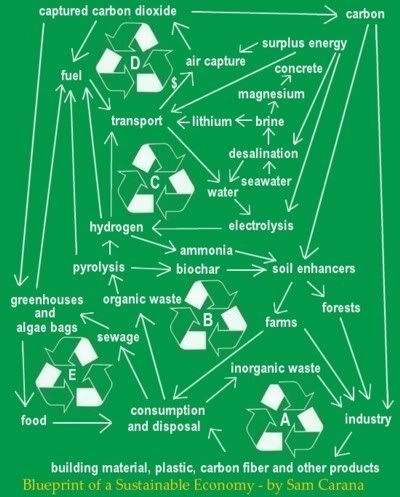Air capture of carbon dioxide is an essential part of the blueprint to reduce carbon dioxide to acceptable levels. Fees on conventional jet fuel seem the most appropriate way to raise funding to help with the development of air capture technology.
Why target jet fuel? In most other industries, there are ready alternatives to the use of fossil fuel. Electricity can be produced by wind turbines or by solar or geothermal facilities with little or no emissions of greenhouse gases. In the case of aviation, though, the best we can aim for, in the near future at least, is biofuel.
Technically, there seem to be no problems in powering aircraft with biofuel. Back in Jan 7, 2009, a Continental Airlines commercial aircraft (a Boeing 737-800) was powered in part by algae oil, supplied by Sapphire Energy. The main hurdle appears to be that algae oil is not perceived as price-competitive with fossil fuel-based jet fuel.
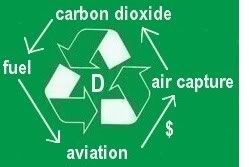 Additionally, the aviation industry can offset emissions, e.g. by funding air capture of carbon dioxide. The carbon dioxide thus captured could be partly used to produce fuel, which could in turn be used by the aviation industry, as pictured on the left. The carbon dioxide could also be used to assist growth of biofuel, e.g. in greenhouses.
Algae can grow 20 to 30 times faster than food crops. A CNN report, more than a year ago, mentions Vertigro's claim to be able to grow 100,000 gallons of algae oil per acre per year by growing algae in clear plastic bags suspended vertically in a greenhouse. Given the right temperature and sufficient supply of light, water and nutrients, algae seem able to supply an almost limitless amount of biofuel.
The potential of algae has been known for decades. As another CNN report describes, the U.S. Department of Energy (DoE) had a program for nearly two decades, to study the potential of algae as a renewable fuel. The program was run by the DoE's National Renewable Energy Laboratory (NREL) and was terminated by 1996. At that time, a NREL report concluded that an area around the size of the U.S. state of Maryland could cultivate algae to produce enough biofuel to satisfy the entire transportation needs of the U.S.
In conclusion, it would make sense to impose fees on conventional jet fuel and use the proceeds of those fees to fund air capture of carbon dioxide.
Additionally, the aviation industry can offset emissions, e.g. by funding air capture of carbon dioxide. The carbon dioxide thus captured could be partly used to produce fuel, which could in turn be used by the aviation industry, as pictured on the left. The carbon dioxide could also be used to assist growth of biofuel, e.g. in greenhouses.
Algae can grow 20 to 30 times faster than food crops. A CNN report, more than a year ago, mentions Vertigro's claim to be able to grow 100,000 gallons of algae oil per acre per year by growing algae in clear plastic bags suspended vertically in a greenhouse. Given the right temperature and sufficient supply of light, water and nutrients, algae seem able to supply an almost limitless amount of biofuel.
The potential of algae has been known for decades. As another CNN report describes, the U.S. Department of Energy (DoE) had a program for nearly two decades, to study the potential of algae as a renewable fuel. The program was run by the DoE's National Renewable Energy Laboratory (NREL) and was terminated by 1996. At that time, a NREL report concluded that an area around the size of the U.S. state of Maryland could cultivate algae to produce enough biofuel to satisfy the entire transportation needs of the U.S.
In conclusion, it would make sense to impose fees on conventional jet fuel and use the proceeds of those fees to fund air capture of carbon dioxide.
 Apart from growing algae in greenhouses, we should also consider growing them in bags. NASA scientists are proposing algae bags as a way to produce renewable energy that does not compete with agriculture for land or fresh water. It uses algae to produce biofuel from sewage, using nutrients from waste water that would otherwise be dumped and contribute to pollution and dead zones in the sea.
Apart from growing algae in greenhouses, we should also consider growing them in bags. NASA scientists are proposing algae bags as a way to produce renewable energy that does not compete with agriculture for land or fresh water. It uses algae to produce biofuel from sewage, using nutrients from waste water that would otherwise be dumped and contribute to pollution and dead zones in the sea.
 The NASA article conservatively mentions that some types of algae can produce over 2,000 gallons of oil per acre per year. In fact, most of the oil we are now getting out of the ground comes from algae that lived millions of years ago. Algae still are the best source of oil we know.
In the NASA proposal, there's no need for land, water, fertilizers and other nutrients. As the NASA article describes, the bags are made of inexpensive plastic. The infrastructure to pump sewage to the sea is already in place. Economically, the proposal looks sound, even before taking into account environmental benefits.
Jonathan Trent, lead research scientist on the Spaceship Earth project at NASA Ames Research Center, Moffett Field, California, envisages large plastic bags floating on the ocean. The bags are filled with sewage on which the algae feed. The transparent bags collect sunlight that is used by the algae to produce oxygen by means of photosynthesis. The ocean water helps maintain the temperature inside the bags at acceptable levels, while the ocean's waves also keep the system mixed and active.
The NASA article conservatively mentions that some types of algae can produce over 2,000 gallons of oil per acre per year. In fact, most of the oil we are now getting out of the ground comes from algae that lived millions of years ago. Algae still are the best source of oil we know.
In the NASA proposal, there's no need for land, water, fertilizers and other nutrients. As the NASA article describes, the bags are made of inexpensive plastic. The infrastructure to pump sewage to the sea is already in place. Economically, the proposal looks sound, even before taking into account environmental benefits.
Jonathan Trent, lead research scientist on the Spaceship Earth project at NASA Ames Research Center, Moffett Field, California, envisages large plastic bags floating on the ocean. The bags are filled with sewage on which the algae feed. The transparent bags collect sunlight that is used by the algae to produce oxygen by means of photosynthesis. The ocean water helps maintain the temperature inside the bags at acceptable levels, while the ocean's waves also keep the system mixed and active.
 The bags will be made of “forward-osmosis membranes”, i.e. semi-permeable membranes that allow fresh water to flow out into the ocean, while preventing salt from entering and diluting the fresh water inside the bag. Making the water run one way will retain the algae and nutrients inside the bags. Through osmosis, the bags will also absorb carbon dioxide from the air, while releasing oxygen. NASA is testing these membranes for recycling dirty water on future long-duration space missions.
As the sewage is processed, the algae grow rich, fatty cells that are loaded with oil. The oil can be harvested and used, e.g., to power airplanes.
In case a bag breaks, it won’t contaminate the local environment, i.e. leakage won't cause any worse pollution than when sewage is directly dumped into the ocean, as happens now. Exposed to salt, the fresh water algae will quickly die in the ocean.
The bags are expected to last two years, and will be recycled afterwards. The plastic material may be used as plastic mulch, or possibly as a solid amendment in fields to retain moisture.
The bags will be made of “forward-osmosis membranes”, i.e. semi-permeable membranes that allow fresh water to flow out into the ocean, while preventing salt from entering and diluting the fresh water inside the bag. Making the water run one way will retain the algae and nutrients inside the bags. Through osmosis, the bags will also absorb carbon dioxide from the air, while releasing oxygen. NASA is testing these membranes for recycling dirty water on future long-duration space missions.
As the sewage is processed, the algae grow rich, fatty cells that are loaded with oil. The oil can be harvested and used, e.g., to power airplanes.
In case a bag breaks, it won’t contaminate the local environment, i.e. leakage won't cause any worse pollution than when sewage is directly dumped into the ocean, as happens now. Exposed to salt, the fresh water algae will quickly die in the ocean.
The bags are expected to last two years, and will be recycled afterwards. The plastic material may be used as plastic mulch, or possibly as a solid amendment in fields to retain moisture.
 A 2007 Bloomberg report estimated that the Gulf of Mexico's Dead Zone would reach more than half the size of Maryland that year and stretch into waters off Texas. The Dead Zone endangers a $2.6 billion-a-year fishing industry. The number of shrimp fishermen licensed in Louisiana has declined 40% since 2001. Meanwhile, U.S. farmers in the 2007 spring planted the most acreage with corn since 1944, due to demand for ethanol. As the report further describes, the Dead Zone is fueled by nitrogen and other nutrients pouring into the Gulf of Mexico, and corn in particular contributes to this as it uses more nitrogen-based fertilizer than crops such as soybeans.
The Louisiana coast seems like a good place to start growing algae in bags floating in the sea, filled with sewage that would otherwise be dumped there. It does seem a much better way to produce biofuel than by subsidizing corn ethanol.
According to zFacts.com, corn ethanol subsidies totaled $7.0 billion in 2006 for 4.9 billion gallons of ethanol. That's $1.45 per gallon of ethanol (or $2.21 per gallon of gas replaced). As zFacts.com explains, besides failing to help with greenhouse gases and having serious environmental problems, corn ethanol subsidies are very expensive, and the political backlash in the next few years, as production and subsidies double, will damage the effort to curb global warming.
At UN climate talks in Bonn, the world's poorest nations proposed a levy of about $6 on every flight to help them adapt to climate change. Benito Müller, environment director of the Oxford Institute for Energy Studies and author of the proposal, said that air freight was deliberately not included. The levy could raise up to $10 billion per year and would increase the average price of an international long-haul fare by less than 1% for standard class passengers, but up to $62 for people traveling first class.
In the light of those amounts, it doesn't seems unreasonable to expect that fees imposed on conventional jet fuel could raise billions per year. Proceeds could then be used to fund rebates on air capture of carbon dioxide, which could be pumped into the bags on location to enhance algae growth. Air capture devices could be powered by surplus energy from offshore wind turbines. With the help of such funding, the entire infrastructure could be set up quickly, helping the environment, creating job opportunities, making the US less dependent on oil imports, while leaving us with more land and water to grow food, resulting in lower food prices.
A 2007 Bloomberg report estimated that the Gulf of Mexico's Dead Zone would reach more than half the size of Maryland that year and stretch into waters off Texas. The Dead Zone endangers a $2.6 billion-a-year fishing industry. The number of shrimp fishermen licensed in Louisiana has declined 40% since 2001. Meanwhile, U.S. farmers in the 2007 spring planted the most acreage with corn since 1944, due to demand for ethanol. As the report further describes, the Dead Zone is fueled by nitrogen and other nutrients pouring into the Gulf of Mexico, and corn in particular contributes to this as it uses more nitrogen-based fertilizer than crops such as soybeans.
The Louisiana coast seems like a good place to start growing algae in bags floating in the sea, filled with sewage that would otherwise be dumped there. It does seem a much better way to produce biofuel than by subsidizing corn ethanol.
According to zFacts.com, corn ethanol subsidies totaled $7.0 billion in 2006 for 4.9 billion gallons of ethanol. That's $1.45 per gallon of ethanol (or $2.21 per gallon of gas replaced). As zFacts.com explains, besides failing to help with greenhouse gases and having serious environmental problems, corn ethanol subsidies are very expensive, and the political backlash in the next few years, as production and subsidies double, will damage the effort to curb global warming.
At UN climate talks in Bonn, the world's poorest nations proposed a levy of about $6 on every flight to help them adapt to climate change. Benito Müller, environment director of the Oxford Institute for Energy Studies and author of the proposal, said that air freight was deliberately not included. The levy could raise up to $10 billion per year and would increase the average price of an international long-haul fare by less than 1% for standard class passengers, but up to $62 for people traveling first class.
In the light of those amounts, it doesn't seems unreasonable to expect that fees imposed on conventional jet fuel could raise billions per year. Proceeds could then be used to fund rebates on air capture of carbon dioxide, which could be pumped into the bags on location to enhance algae growth. Air capture devices could be powered by surplus energy from offshore wind turbines. With the help of such funding, the entire infrastructure could be set up quickly, helping the environment, creating job opportunities, making the US less dependent on oil imports, while leaving us with more land and water to grow food, resulting in lower food prices.
Geo-engineering is the study and implementation of technical ways to change (and arguably improve) things like weather patterns, river paths, soils, climates and sea currents on Earth. Recently, geo-engineering has received special attention for efforts to combat global warming.
Monday, May 4, 2009
Funding of Carbon Air Capture
Monday, April 20, 2009
Open Letter to Major Economies Forum on Energy and Climate
We, a group of scientists, researchers and other people sharing a strong background and interest in climate change, are concerned that the Forum's sole focus will be on the politics of energy, as seems confirmed by the name of the Forum.
We believe that the scientific evidence strongly suggests that the approach to the climate change problem should be as broadly based as possible. As such, this should include the following four parts:
Part A: Emissions reduction
Part B: Carbon stock management
Part C: Heat transfer and radiation management
Part D: Adaptation
We note that there is little or no funding for research and testing of geoengineering methods (in Part B and Part C). These should be urgently considered as part of a comprehensive approach to climate change.
Signatories:
- John Nissen (jn@cloudworld.co.uk)
- Andrew Lockley (Former director of Friends of the Earth ENWI - UK)
- Peter Read (Hon. Research Fellow, Massey University Centre for Energy Research - NZ)
- Bill Fulkerson (Senior Fellow, Institute for a Secure and Sustainable Environment, University of Tennessee)
- Dan Wylie-Sears
- Eugene I. Gordon
- John Gorman (MA (Chartered Engineer MIMechE, MIET - UK)
- Jim Woolridge (former Climate and Energy Campaigner, Earthwatch/Friends of the Earth, Ireland)
- Sam Carana (contributor to feebate.net - sam.carana@gmail.com)
References:
White House Announcement of Major Economies Forum (MEF)
White House Announcement of Mexico MEF Meeting
Department of State Annoucement of MEF
Open letter to Dr Rajendra K. Pachauri, IPCC chair (Gather)
Open letter to Dr Rajendra K. Pachauri, IPCC chair (Geo-engineering)
Open Letter to Major Economies Forum Participants (background)
Monday, March 9, 2009
Open letter to Dr Pachauri
Climate Congress, Copenhagen, 10-12 March, 2009
Open letter to Dr Rajendra K. Pachauri, IPCC chair
Dear Dr Pachauri,
The Climate Congress presents an important opportunity to present all facets of the current situation, explore the ramifications, and suggest appropriate actions. The aim must be, as far as possible, to address the threat of a disastrous multi-metre rise in sea level and catastrophic multi-degree rise in temperature – whenever they might occur.
We would like to suggest a rather simple division of the problem/solution domain:
About: Reducing emissions of greenhouse gases into the atmosphere.
Target: Achieve near-zero carbon economies throughout the world by end century.
Difficulties: International agreement, life-style changes, high cost.
Rationale: Long-term sustainability.
Part B : Carbon stock management
About: Removing CO2 from the atmosphere by various means.
Target: Reduce levels below 350 ppm over next three decades.
Difficulties: May involve change in agricultural practice, worldwide. Side-effects may be difficult to anticipate.
Part C : Heat transfer and radiation management
About: Mainly about albedo engineering and solar radiation management.
Priority target: Cool the Arctic sufficient to halt retreat of Arctic sea ice within three years.
Difficulties: Seen as tampering with the environment, and therefore intrinsically dangerous; but cost is low and side-effects should be manageable.
Rationale: Reduce risk of massive methane discharge and stabilise the Greenland ice sheet.
References:
[1] Climate Safety report, which can be downloaded from:
Wednesday, December 31, 2008
Considerations for New Year
"In my opinion, if we burn all the coal, there is a good chance that we will initiate the runaway greenhouse effect. If we also burn the tar sands and tar shale (a.k.a. oil shale), I think it is a dead certainty." I discussed this danger in the article Venus' runaway greenhouse effect a warning for Earth, originally posted and discussed at Gather.
- describe risk and estimate chances of manifestation, timelines, etc.
- identify tipping points, feedback mechanisms and give estimate ranges of their combined impact
- investigate ways to avoid it, mitigate it, etc.
- conduct comparative analysis of the various proposals
- make recommendations
Wednesday, December 24, 2008
Ken Caldeira named among science heroes of 2008
Caldeira, of the Carnegie Institution, has been investigating geoengineering claims for years. This year he was brought in by the British government to talk about ways in which we could geoengineer the climate to save us from global warming. If we don't get greenhouse gas emissions down, we're going to need a Plan B - and people like Caldeira to do the research for us. He's also been asked to organise a session on geoengineering in Copenhagen next year, where world leaders will meet to sign the successor to the Kyoto protocol.
http://www.newscientist.com/article/dn16299-science-heroes-and-villains-of-2008.html
=============
Congratulations, Ken!
Cheers! Sam Carana
heat-reflecting sheets
The team's calculations suggest that covering an area of a little more than 60,000 square kilometres with reflective sheet, at a cost of some $280 billion, would result in net cooling, if there would be no reduction in carbon dioxide emissions.
http://groups.google.com/group/geo-engineering/browse_thread/thread/89da63d8ebef3242
Wednesday, December 17, 2008
Combat Global Warming with Evaporative Cooling

In early 2006, I wondered to what extent such increased cloud coverage could mitigate global warming. On the one hand, the extra clouds will reflect more sunlight back into space, but on the other hand water vapor is itself a greenhouse gas. While the albedo difference between clouds and sea water is obvious, some of the evaporated water could rise higher up into the atmosphere and increase humidity of cirrus clouds at high altitudes, thus trapping the heat underneath and heating up Earth even further through the greenhouse effect. Also, such evaporation could cause unwanted salty rain to fall over land.
Has anyone done any modeling on this?
Cheers!
Tuesday, November 4, 2008
Adding lime to seawater
Due to increased CO2 levels, the oceans have become more acid. Adding lime (calcium hydroxide) to seawater will increase the alkalinity of the water, making the water absorb more CO2 and reducing the release of CO2 from the water into the atmosphere.
Tim Kruger, a management consultant at London-based Corven, believes that this can be done most economically where there's plenty of limestone, and plenty of energy that is too remote to exploit for conventional commercial purposes.
"There are many such places — for example, Australia's Nullarbor Plain would be a prime location for this process, as it has 10,000km3 of limestone and soaks up roughly 20MJ/m2 of solar irradiation every day," said Kruger.
Although the process generates CO2 emissions, on paper it sequesters twice as much of the warming gas than it produces. Kruger says the process is therefore 'carbon negative'.
'This process has the potential to reverse the accumulation of CO2 in the atmosphere. It would be possible to reduce CO2 to pre-industrial levels,' he explained.
"We think it's a promising idea," says Shell's Gilles Bertherin, a coordinator on the project, which is being developed in an "open source" manner. "There are potentially huge environmental benefits from addressing climate change — and adding calcium hydroxide to seawater will also mitigate the effects of ocean acidification, so it should have a positive impact on the marine environment."
Sources and Links:
Shell Oil funds "open source" geoengineering project to fight global warming, at:
Mongabay.com
'Turning back the clock on climate change' - A technology to reverse climate change? To reduce ocean acidification? And that also promises to increase food production? Cath O’Driscoll investigates, at:
Chemistry & Industry Magazine
Adding lime to seawater feasibility study, funded by Shell, at:
Inventory of geo-engineering proposals
Thursday, October 23, 2008
Removing carbon from air - Discovery Channel
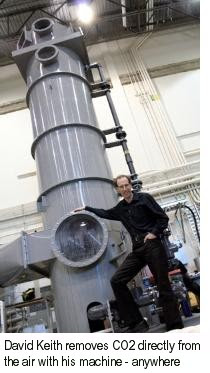 Professor David Keith of the University of Calgary is working on a device that removes carbon dioxide directly from ambient air.
Professor David Keith of the University of Calgary is working on a device that removes carbon dioxide directly from ambient air.Keith has built a tower, 4 feet wide and 20 feet tall, with a fan at the bottom that sucks air in. Keith expects the air coming out at the top to have approximately 50% less carbon dioxide than the air coming in.
The tower features in an episode of Discovery Channel’s new “Project Earth” series on TV. The series has the largest budget of any in Discovery Channel’s history, and it may eventually attract a global viewership of more than 100 million.
The episode on Keith’s research has already aired in the U.S. - if you're missed it, you can watch it on Discovery Channel’s website, at: http://dsc.discovery.com/tv/project-earth/project-earth.html - click on “Episodes.”
If the program hasn't aired in your country, you may not get access to the online episode, but you can read more at: http://dsc.discovery.com/tv/project-earth/lab-books/fixing-carbon/guide1.html - also click on the links under "MORE CARBON".
The picture below describes the Big Picture of recycling, in which I envisage aviation to fund CO2 air capture. When talking about recycling, most people think about recycling of industrial products only. They may also see composting of organic waste as a (second) way of recycling. Instead of composting, I actually envisage organic waste to be burned by means of pyrolysis, in order to produce agrichar and hydrogen. I also envisage a third way of recycling that includes removing CO2 from the air. This CO2 could also be used for the production of agrichar and for commercial purposes such as to enrich greenhouses and for the production of building material, carbon fiber, etc. Furthermore, this CO2 could be used as fuel for aviation.
To tackle emissions by aviation, we can switch to airplanes and helicopters that are powered by batteries and hydrogen, or switch to fuels other than fossil fuel. Growth of algae could be assisted by such captured CO2, which could also be turned directly into fuel.
By financially supporting air capture of CO2 and the use of such CO2 to produce fuel, aviation could close the circle of this third way of recycling. This could make aviation environmentally sustainable. Since government is such a large user of aviation (both the military and civil parts of government), it makes sense for the government to start funding such air capture as soon as possible. An international agreement, to be reached in Copenhagen in 2009, could further arrange for the proceeds of environmental fees on commercial flights to fund such air capture and its use for fuel.
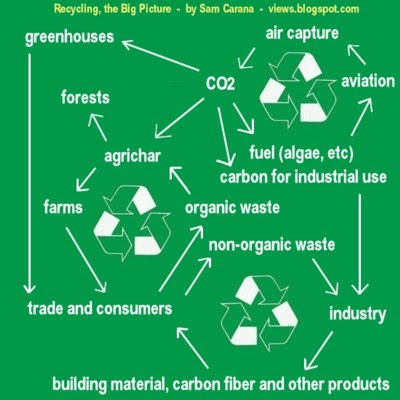
Further links:
http://dsc.discovery.com/tv/project-earth/explores/carbon.html - Discovery Channel
http://www.ucalgary.ca/news/september2008/keith-carboncapture - David Keith
http://www.ucalgary.ca/~keith/AirCapture.html - David Keith
http://www.ucalgary.ca/~keith/Misc/AC%20talk%20MIT%20Sept%202008.pdf - M.I.T.
views.blogspot.com - by Sam Carana
The post below is added for archival purposes. It was originally posted by Sam Carana at knol in 2009, which has meanwhile been discontinued by Google. The post received 4513 views at knol.
Funding of Carbon Air Capture
HOW CAN CO2 CAPTURE FROM AMBIENT AIR BEST BE FUNDED?
FEES ON JET FUEL CAN HELP FUND THE DEVELOPMENT OF CARBON CAPTURE FROM AMBIENT AIR.
 AIR CAPTURE of CO2 (carbon dioxide) is an essential part of the blueprint to reduce carbon dioxide to acceptable levels. Fees on
AIR CAPTURE of CO2 (carbon dioxide) is an essential part of the blueprint to reduce carbon dioxide to acceptable levels. Fees on  conventional jet fuel seems the most appropriate way to raise funding to help with the development of air capture technology.
conventional jet fuel seems the most appropriate way to raise funding to help with the development of air capture technology.Why target jet fuel? In most other industries, there are ready alternatives to the use of fossil fuel. Electricity can be produced by wind turbines or by solar or geothermal facilities with little or no emissions of greenhouse gases. In the case of aviation, though, the best we can aim for, in the near future at least, is biofuel or synthetic fuel, produced from CO2 captured from ambient air. As discussed below, development of these two forms of renewable energy can go hand in hand.
Additionally, the aviation industry can offset emissions, e.g. by funding air capture of carbon dioxide. The carbon dioxide thus captured could be partly used to produce fuel, which could in turn be used by the aviation industry, as pictured on the top right image. The carbon dioxide could also be used to assist growth of biofuel, e.g. in greenhouses and in algae bags, as described below.
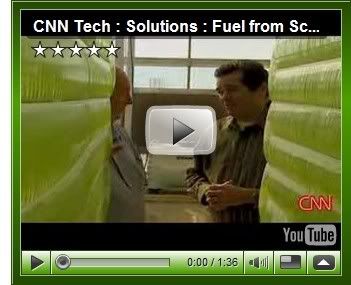 Algae can grow 20 to 30 times faster than food crops. As the CNN video on the right mentions, Vertigro claims to be able to grow 100,000 gallons of algae oil per acre per year by growing algae in clear plastic bags suspended vertically in a greenhouse. Given the right temperature and sufficient supply of light, water and nutrients, algae seem able to supply an almost limitless amount of biofuel.
Algae can grow 20 to 30 times faster than food crops. As the CNN video on the right mentions, Vertigro claims to be able to grow 100,000 gallons of algae oil per acre per year by growing algae in clear plastic bags suspended vertically in a greenhouse. Given the right temperature and sufficient supply of light, water and nutrients, algae seem able to supply an almost limitless amount of biofuel. Apart from growing algae in greenhouses, we should also consider growing them in bags. NASA scientists are proposing algae bags as a way to produce renewable energy that does not compete with agriculture for land or fresh water. It uses algae to produce biofuel from sewage, using nutrients from waste water that would otherwise be dumped and contribute to pollution and dead zones in the sea.
Apart from growing algae in greenhouses, we should also consider growing them in bags. NASA scientists are proposing algae bags as a way to produce renewable energy that does not compete with agriculture for land or fresh water. It uses algae to produce biofuel from sewage, using nutrients from waste water that would otherwise be dumped and contribute to pollution and dead zones in the sea. The NASA article conservatively mentions that some types of algae can produce over 2,000 gallons of oil per acre per year. In fact, most of the oil we are now getting out of the ground comes from algae that lived millions of years ago. Algae still are the best source of oil we know.
The NASA article conservatively mentions that some types of algae can produce over 2,000 gallons of oil per acre per year. In fact, most of the oil we are now getting out of the ground comes from algae that lived millions of years ago. Algae still are the best source of oil we know.In the NASA proposal, there's no need for land, water, fertilizers and other nutrients. As the NASA article describes, the bags are made of inexpensive plastic. The infrastructure to pump sewage to the sea is already in place. Economically, the proposal looks sound, even before taking into account environmental benefits.
Jonathan Trent, lead research scientist on the Spaceship Earth project at NASA Ames Research Center, Moffett Field, California, envisages large plastic bags floating on the ocean. The bags are filled with sewage on which the algae feed. The transparent bags collect sunlight that is used by the algae to produce oxygen by means of photosynthesis. The ocean water helps maintain the temperature inside the bags at acceptable levels, while the ocean's waves also keep the system mixed and active.
 The bags will be made of “forward-osmosis membranes”, i.e. semi-permeable membranes that allow fresh water to flow out into the ocean, while preventing salt from entering and diluting the fresh water inside the bag. Making the water run one way will retain the algae and nutrients inside the bags. Through osmosis, the bags will also absorb carbon dioxide from the air, while releasing oxygen. NASA is testing these membranes for recycling dirty water on future long-duration space missions.
The bags will be made of “forward-osmosis membranes”, i.e. semi-permeable membranes that allow fresh water to flow out into the ocean, while preventing salt from entering and diluting the fresh water inside the bag. Making the water run one way will retain the algae and nutrients inside the bags. Through osmosis, the bags will also absorb carbon dioxide from the air, while releasing oxygen. NASA is testing these membranes for recycling dirty water on future long-duration space missions.As the sewage is processed, the algae grow rich, fatty cells that are loaded with oil. The oil can be harvested and used, e.g., to power airplanes.
 A 2007 Bloomberg report estimated that the Gulf of Mexico's Dead Zone would reach more than half the size of Maryland that year and stretch into waters off Texas. The Dead Zone endangers a $2.6 billion-a-year fishing industry. The number of shrimp fishermen licensed in Louisiana has declined 40% since 2001. Meanwhile, U.S. farmers in the 2007 spring planted the most acreage with corn since 1944, due to demand for ethanol. As the report further describes, the Dead Zone is fueled by nitrogen and other nutrients pouring into the Gulf of Mexico, and corn in particular contributes to this as it uses more nitrogen-based fertilizer than crops such as soybeans.
A 2007 Bloomberg report estimated that the Gulf of Mexico's Dead Zone would reach more than half the size of Maryland that year and stretch into waters off Texas. The Dead Zone endangers a $2.6 billion-a-year fishing industry. The number of shrimp fishermen licensed in Louisiana has declined 40% since 2001. Meanwhile, U.S. farmers in the 2007 spring planted the most acreage with corn since 1944, due to demand for ethanol. As the report further describes, the Dead Zone is fueled by nitrogen and other nutrients pouring into the Gulf of Mexico, and corn in particular contributes to this as it uses more nitrogen-based fertilizer than crops such as soybeans.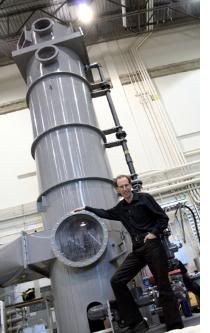 Professor David Keith (left) of the University of Calgary is working on a tower, 4 feet wide and 20 feet tall, with a fan at the bottom that sucks air in. The tower looks like it's made mainly of plastic, which could be made with carbon produced by such a tower. Inside the tower, limestone or a similar agent is used to bind the CO2 and to split CO2 off by heating it up. The limestone is recycled within the tower, although it does need to be resupplied at some stage. Anyway, the main cost appears to be the electricity to run it. Keith and his team showed they could capture CO2 directly from the air with less than 100 kilowatt-hours of electricity per ton of CO2. At $0.10/kWh, that would put the electricity cost at $10 per ton.
Professor David Keith (left) of the University of Calgary is working on a tower, 4 feet wide and 20 feet tall, with a fan at the bottom that sucks air in. The tower looks like it's made mainly of plastic, which could be made with carbon produced by such a tower. Inside the tower, limestone or a similar agent is used to bind the CO2 and to split CO2 off by heating it up. The limestone is recycled within the tower, although it does need to be resupplied at some stage. Anyway, the main cost appears to be the electricity to run it. Keith and his team showed they could capture CO2 directly from the air with less than 100 kilowatt-hours of electricity per ton of CO2. At $0.10/kWh, that would put the electricity cost at $10 per ton.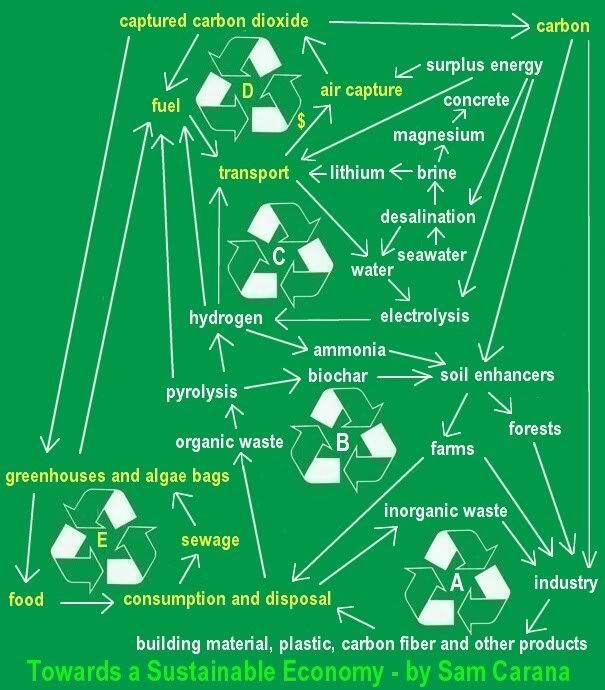
Jul 19, 2010
There are several efforts under development to produce a carbon-neutral fuel. Two of them were recently described in article in New Scientist, entitled: Green machine: Cars could run on sunlight and CO2.
http://www.newscientist.com/article/dn18993-green-machine-cars-could-run-on-sunlight-and-co2.html
See also Sandia
https://share.sandia.gov/news/resources/releases/2007/sunshine.html
Whereas many may think that this is a good way to power cars, I agree with you that it makes more sense to have electric cars. However, aviation is a bit more difficult to clean up, that's why aviation in particular can benefit from such technology, and that would justify that aviation made financial contributions to fund such developments.
As air capture technology matures with financial assistance funded by fees on aviation, it will be in a better position to develop into a more general technology used to reduce CO2 in the atmosphere to more acceptable levels.
http://www.newscientist.com/article/dn19308-the-next-best-thing-to-oil.html
http://www.sciencemag.org/content/330/6012/1797
Milking algae
Instead of harvesting algae for processing into biofuel, there is prospect for "milking" the algae, i.e. extracting oil from the algae without killing them.
This method is followed by Joule Unlimited.
http://www.theglobeandmail.com/news/opinions/opinion/a-brave-new-world-of-fossil-fuels-on-demand/article1871149/
And also by Algenol, Synthetic Genomics (Craig Venter’s venture) and BioCee
http://theenergycollective.com/tyhamilton/50300/joule-cool-not-alone-quest-sunlight-fuel-game-changer
Jul 5, 2011
British company set to make renewable jetfuel
British company Air Fuel Synthesis plans to capture carbon dioxide from the air, and mix it with hydrogen extracted from water through electrolysis, in order to make liquid hydrocarbon fuels for transport, including for aviation.
http://www.airfuelsynthesis.com/technology.html
http://www.airfuelsynthesis.com/technology/technical-review.html
http://www.airfuelsynthesis.com/faqs.html
